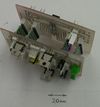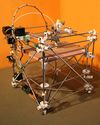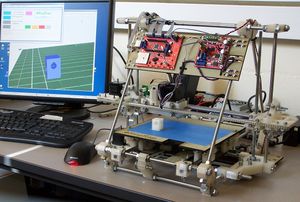Alternative Electronics/ru
|
English • العربية • български • català • čeština • Deutsch • Ελληνικά • español • فارسی • français • hrvatski • magyar • italiano • română • 日本語 • 한국어 • lietuvių • Nederlands • norsk • polski • português • русский • Türkçe • українська • 中文(中国大陆) • 中文(台灣) • עברית • azərbaycanca • |
THIS page is an extremely rough draft. You can help us improve it. (Someday this page will document many of the known-working systems. A few known-working systems are already documented at RepRap Options).
These pages should be merged such that both pages do not attempt to cover the duplicate topics.
Do not let the size of this page discourage you, you have many electronic choices. At the end of the day you need these fundamental components
- A Mainboard
- Stepper Drivers
- Endstops (Optional, see here)
How you get there is up to you. If you don't want to make these kinda of choices simply follow an "offical" build (Color choices below).
| Blue | Mendel "Official" |
| Orange | Huxley "Official" |
Contents
- 1 Single Board Electronics
- 2 Modular Electronics
- 3 Overview
- 4 Overview Electronics Pages
- 5 Recommended
- 6 Experimental, and New ( your new design goes here till at least independently reviewed )
- 7 Deprecated and Older Electronics pages
- 8 DIY Circuit Board Manufacturing
- 9 Theoretical
- 10 Goals
- 11 Testing
- 12 Further Reading
Single Board Electronics
With these solutions, you have all the main components on a single PCB. Stepper drivers are sometimes pluggable (and exchangeable), sometimes with chips soldered directly onto the board.
Typically you also need external endstops, as endstops have to be placed on the printer frame in specific places.
| Pic | Name | Author | License | Based on | RepRap Etchable | Firmware | Status | Notes |
|---|---|---|---|---|---|---|---|---|
 |
Pololu | Adrianbowyer | GPL v2 | Arduino Mega | Yes | FiveD | Experimental/ DEFACTO | |
 |
Generation 7 Electronics | Traumflug | CC BY-NC-SA | LPC1114 (32-bit ARM) | Yes | Teacup | shipping | |
 |
SinapTec | Sinaptec | GPL | Yes | Teacup | ??? | Mount an Arduino Nano ATmega328P | |
 |
T-Bone | Interactive Matter | AGLP/CC SA | Beagle Bone | Untested | any | Release | Versatile, powerful CNC motion controller |
| Duet | Think3DPrint3D and RepRapPro | Cern OHW | ATSAM3X8E | No | RepRapFirmware | Release | All in one, Ethernet, digital current control |
Modular Electronics
Modular electronics have a separate PCB for each main component. You connect them by wiring to get a fully functional electronics. Modules can also serve to extend single board electronics, too.
Mainboard
| Pic | Name | Author | License | Based on | RepRap Etchable | Built-In Optics | Firmware | Status | Notes | ~Component Cost |
|---|---|---|---|---|---|---|---|---|---|---|
 |
1.2 - Gen 3 | atmega644p | No | No | FiveD | Released | ||||
 |
Something Ancient | atmega644p | No | No | Proclarush Taonas 1.0 | Retired | ||||
 |
Tekzone Remix Mainboard | Kymberlyaandrus | atmega644p | No | ? | Working | ||||
 |
CN Controls | MaukCC | CC BY_NC_SA 4.0 | Arduino | No | No | Marlin | Working |
Stepper Drivers
- Main article: stepper motor driver.
| Pic | Name | Author | License | Based on | RepRap Etchable | Soldering Required | Rating Per Coil | Status | Notes | Purchase Assembled | ~Component Cost |
|---|---|---|---|---|---|---|---|---|---|---|---|
 |
TMC2100 | Skimmy? | CC-BY-SA | ? | ? | ? | 1.25A RMS continuous | shipping | ? | Watterott | ? |
 |
RAPS128 | ? | CC-BY-NC-SA | ? | ? | ? | ? | ? | ? | ? | ? |
 |
STB Cool Stepper Driver | ? | CC-BY-NC-SA | ? | ? | ? | ? | ? | ? | ? | ? |
 |
Stepper Motor Driver 2.3 | GPL | Allegro A3982 | ?No? | Surface Mount | 2A | Released | PCB Here | |||
| |
StepStick | GPL V2 | Allegro A4983 & A4988 | ? | Reflow | 2A | Development | A drop in replacement for any Pololu stepper driver board. Four drivers on one board fit perfectly into Sanguinololu or break apart for other electronics | Check eBay for Stepstick "Twigs" | ~$25 USD (for all 4 drivers) | |
 |
Tri Duino Stepper | GPL | ATMEGA168 & ULN2803A | ?Yes? | through-hole | 1A | Development | ? | ? |
Endstops
See Endstop.
Extruder Controller
Also see: toolcontroller
Overview
The page RepRapElectronics has a good high-level description of what the electronics do and how they connect to the rest of the system. The standard, well-tested RepRap electronics are described at circuit board construction. Various ways of mounting and cooling RepRap electronics (whether standard or nonstandard) are described at Electronics Improvements.
Many people have come up with ideas for improving on those electronics. We list and compare and contrast some of those ideas here.
Feel free to download the current version of the RepRap electronics on SourceForge and make improvements, rather than starting from scratch.
If you want to know about the weird naming convention/s being used here, including the strange ( and broken) "Gen X" nomenclature, please see Electronics_Variations.
Overview Electronics Pages
- Mendel Buyers Guide and PartsSupplies list a few places to buy a complete kit of electronics
- circuit board construction -- the standard RepRap electronics, currently Mendel
Recommended
- main: list of electronics
- RAMPS -- An Arduino Mega shield-type board. Very popular.
- Sanguinololu -- a low-cost expandable all in one solution
- R2C2 electronics -- complete solution, quality and fast electronics, a really new generation of electronics for RepRap 3D printers and others like RapMan. Professional made but also development/hack friendly :-)
- Smoothieboard -- modern, fast, easy to use all-in-one solution. 32bit with web interface
- Generation 7 Electronics -- easy single board solution, designed for do-it-yourself.
- Generation 6 Electronics -- easy plug n play electronics, single board solution
- Pololu Electronics -- very simple electronics that can be printed by RepRap itself. Can also be built on stripboard. Fully tested, and supported by the standard RepRap software.
- SAV MkI -- an inexpensive yet feature rick controller board designed within the Spanish RepRap community Clone Wars Project
Experimental, and New ( your new design goes here till at least independently reviewed )
- Danguinololu -- A fully-integrated board with excellent cooling and debug facilities and easy-to-solder motor drivers, inspired by the Sanguinololu schematic.
- Gen_L_Electronics -- Designed to be very low cost, easy to assemble, but tethered to a computer via USB
- StepStick A low-cost drop in replacement for Pololus motor drivers - A4983/A4988
- Repic -- "as simple as possible" all-in-one electronics based on PIC18F4550 or PIC24, on single-sided, through-hole PCB.
- Easy_electronics -- Sanguinololu firmware compatible board for dual extruder operation with built in 128x64 dots graphic LCD, click encoder wheel, SD-Card connector and USB interface. Easy to use all in one solution.
- STB_Electronics -- Sanguinololu firmware compatible board with graphic LCD, click encoder wheel, SD-Card and USB
- Melzi -- Sanguinololu firmware compatible board.
- MaKrMelzi -- improved Melzi board with exchangeable driver modules and support for graphical LCD
- Azteeg_X1 -- SMD remix of Sanguinololu +more.
- Harvey -- STM32F102 Cortex-M3 allmost-all-smd compact extendable all in one board ftw
- Megatronics -- Improvement over RAMPS, single board solutions with a lot of options. Very cheap compared to other options
- Rambo -- RepRap Arduino-compatible Mother Board : All in one RAMPS
- RUMBA -- R.eprap U.niversal M.ega B.oard with A.llegro driver : All in one RAMPS
- Phoenix -- easy for beginners to construct and repair: all through-hole parts
- All In One Electronics
- Brainwave
- grblShield ([1], [2]), from the same people who brought you grbl.
- Cheaptronic
Deprecated and Older Electronics pages
- main page: List of Abandoned and Deprecated Electronics
- Generation 4 Electronics -- makerbot electronics
- Generation 3 Electronics -- also the standard Mendel RepRap electronics
- Generation 3 Electronics/Tech Zone Remix -- Gen3 electronics with a more compact layout
- Generation 2 Electronics -- a set of electronics still working for current machine designs. Some prefer it, as it's easier to solder (no SMD).
- Gen2OnABoard
- BuildingTheCommonElectronicsForAllTheControlBoards -- the earlier standard boards for Darwin
- Laser Cutter control electronics are very different from motor drivers and extruder controllers.
- Hacks to the RepRap Extruder Controller v2.2
- Hacks to the RepRap Motherboard v1.1
- PCB adaptions for Mendel -- converting the fully-assembled MakerBot CupCake electronics to use screw terminals for RepRap
- BuildingAStripboardStepperController -- deprecated.
- MakeIDCCable -- the cables used in many (most? all?) RepRaps and RepStraps.
- 4 Axis TB6560 CNC Stepper Motor Driver Board Controller -- 4 Axis TB6560 CNC Stepper Motor Driver Board Controller (4+1 channel CNC board ment to be used from parallel port but can be easily used from mcu. Includes opto insulation, 4 stepper channels and 1 relay. Includes large heat sink and is capable of running steppers up to 24V, 3A)
DIY Circuit Board Manufacturing
- According to some estimates, the vast majority of RepRap and RepStrap machines use one of the above custom PCBs specifically designed for RepRap and fabbed by a commercial PCB fabricator. Mendel Buyers Guide and PartsSupplies lists some of the places selling such PCBs, either the empty PCB or the assembled PCBA with all the parts already soldered on.
- Many developers assemble extremely experimental electronic prototypes on bits of stripboard[3]. See the "Stripboard Designer" section of Useful Software Packages.
- A few developers assemble extremely experimental electronic prototypes on solderless breadboard -- Tri Duino Stepper, Teensy Breadboard, etc.
- A few developers fabricate their own custom PCBs with a relatively crude homebrew process:
Theoretical
Various pie-in-the-sky ideas ...
- One of the more fascinating ideas is to use the RepRap itself to help manufacture the next generation of electronics. We talk more about that idea on the Automated Circuitry Making page.
- Is it possible to build a RepRap that, instead of using the standard Stepper Motor Driver 2.3 boards, instead used some other stepper motor driver boards? perhaps the open-source OpenStepper boards ( from http://openservo.com/ ) or the open-source Linistepper ( from http://www.romanblack.com/lini.htm )?
- Is it possible to build a RepRap that, instead of using stepper motors, instead used slower, smaller, cheaper hobby R/C servo motors?
- perhaps driven by the servo motor driver board plus magnetic encoder board combination -- MagServo or OpenEncoder )?
- perhaps driven by the servo motor board plus a sub-$2 mechanical encoder?[4]
- Is it possible to build a RepRap that, instead of using stepper motors, uses faster, bigger, more expensive DC motors?
- Is it possible to build a RepRap that, instead of using stepper motors, uses faster, bigger, more expensive AC motors?
- Is it possible to build a RepRap that, instead of using stepper motors, uses nitinol shape-memory wire?
- Is it possible to build a RepRap that can print photovoltaic cells?
- Is it possible to build a RepRap that, instead of using 8-bit Atmel AVR microcontrollers, instead uses 32-bit ARM microcontrollers -- perhaps one of the ones listed at Vaporware Electronics ?
- Rather than limit the HW to a set number of Axis, Dynamically expandable Bus Driven Approach
Goals
See Development Pathway for goals and ideas for improving RepRap in general. Here, we focus ideas for improving the electronics alone.
There are a variety of ways of "improving" the RepRap electronics -- but, alas, several of these ways conflict with each other:
- reduce the net cost of all the motors and electronics and connectors, when fabricated and assembled at commercial PCB fab and board assembly house in high volumes. This seems to imply putting everything on one board, eliminating the cost of connectors between boards; eliminating parts that are not absolutely essential to run a single RepRap with a single extruder; and using tiny narrow-pitch surface-mount components packed tightly together, to reduce the size and therefore cost of the PCB.
- add one or more features that early RepRap electronics doesn't have
- SD card reader and LCD screen so that it can run "stand-alone" disconnected from any PC host.
- high-power stepper drivers to drive bigger, faster RepRaps
- 7 stepper drivers so it can run 3 axis plus 4 extruder heads -- a Mendel Multiple Extruder -- or a Stewart platform plus 1 extruder head, etc.
- lots of thermistors so it can occasionally pause and wait for motors and motor drivers to cool off if necessary, rather than covering them with enough heavy heat sinks to cover the worst case.
- all the stuff necessary to interface with magnetic linear encoders or optical linear encoders to directly measure the position of the tool head. This lets the firmware immediately detect and correct "skipped steps" ... and also enables microstepping with optical feedback that may give higher positioning precision.
- make it possible for people to fab the boards with a relatively crude homebrew process -- perhaps one of the Automated Circuitry Making techniques. This implies spacing parts relatively far apart to leave more room for the relatively wide isolation gaps and wide traces these techniques produce.
- As far as possible, use only widely-available parts that are unlikely to go obsolete soon -- available from multiple manufacturers, etc.
- Lots of flexibility to allow a variety of "functional units" to be substituted. Then the assembler can use whatever is cheapest at the time and location. Easy to switch to alternate parts if the original parts are unavailable. Easy to experiment by temporarily swapping in a new functional unit to test if it is really better than the old unit. Easy to upgrade just one functional unit if a better unit becomes available -- less buggy, more fault-tolerant, faster, more power-efficient, etc.
- Each motor driver on a separate board, for the reasons listed at PMinMO: "Why Modular Designs?".
- make it possible for people to assemble all the parts on the boards with relatively crude soldering tools -- this implies easy-to-solder parts, either through-hole parts or large wide-pitch surface-mount parts.
Perhaps the biggest philosophical conflict between RepRap PCB designers is between people who are aiming in two very different directions:
- A completely stand-alone RepRap. A person turns on the RepRap, presses buttons on the RepRap to select "measuring cup" on its small LCD panel, and then the RepRap prints out a measuring cup. Since there is no PC hooked to it, all computation is done internally with a medium-cost processor, and all status shows up on the LCD panel and a few dozen blinking LEDs.
- A "3D printer" as a dedicated computer peripheral. A person designs a new measuring cup on a full-size computer running his favorite operating system and his favorite 3D CAD software, hits "print", and then the RepRap prints out a measuring cup. Since it's hooked up to a PC with a (relatively) fast processor and (relatively) huge display screen, it offloads as much computation and status display as possible to the PC. The internal low-cost processor handles the remaining real-time tasks that cannot be done by the PC.
Testing
- Does it work at all? Testing RepRap Electronics
- How do I use the RepRap Stepper Tester?
- How do I use the OpenCircuits Stepper Tester?
- Does it shut off properly when it overheats or slams into an end-stop?
- What is the cost compared to the standard RepRap electronics?
- Does it print things faster than the standard RepRap electronics?
- Does it print things more accurately than the standard RepRap electronics?
The process of releasing improved electronic designs in a way that makes it easy for other people to use and make further improvements is described at ElectronicsReleaseProcess.
Further Reading
- RepRap Electronics forum -- mostly talks about things that have gone wrong; perhaps you can figure out how to make future electronics less vulnerable to these problems.
- Reprap Electronics Development specifically discusses developing new electronics.
- The Mailing Lists at reprap-dev -- RepRap 3D printing development often talks about developing electronics.
- Mechanical Computer
- Electronics
